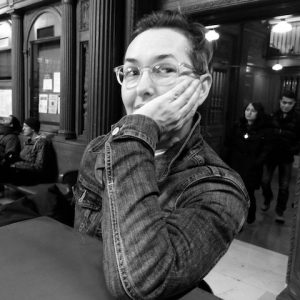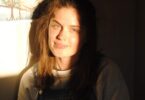Alison Dowsett
I. As Idea
Years ago my friend sent me a draft of an essay she was writing for The Capilano Review titled, “What Literature Wants.” Several years before, we had been neighbours, which is when she introduced me to the work of Clarice Lispector and Hélène Cixous. She was a visual artist so my mind flushed with anticipation of reading her take on such a bold proposition.
I wanted it to be so satisfying: an exhaustive rant: a thought-provoking take on forms: a cascade of language giving the impression of a typographical mash-up like one of her text canvases. The impetus for those canvases had been text in the urban streetscape. I remember the large stack of photographs on her expansive and cluttered worktable, developed from close to ten rolls of film. Each photo an isolated letter or symbol from shop windows, bus shelter ads, street signs. She had deconstructed those names, declarations and suggestions. The ornate T from the taco shop sign, the workaday white M from the blue Laundromat sign, the numbers six, four and nine from the lotto sign that hangs in the window of every corner store in the country. Her grand mixed-media canvases transformed street typography into a freshly ordered chaos.
When I read her darting prose I tried to hang on to the threads but kept losing them. I searched for symbols to repeat. I peeled my eyes for an idea, an emotion. Warmth. Her son appeared; I was hopeful. They took a walk to the sprawling parkway in the boulevard of a busy Vancouver thoroughfare. It was a non-starter. Then a romantically attired barista appeared at an espresso bar on Main Street and proceeded not to payoff. By the end I wasn’t sure what had happened. No interaction with language, no sustaining imagery, only randomness. I was ashamed to admit that I craved a story but it was true. I craved some kind of meaning or maybe unification is the word.
Why were her canvases so successful at unleashing the bizarre beauty of the commercial environment? Why was her prose so unable to move me?
I say I was ashamed because I, like her, gravitate to the experimental. I like being challenged by what I read. But in the end, I was too challenged.
In the days and months that passed the question stayed with me, co-opting my concentration and creating a sense of anticipation that I narrowed on, waiting for an answer to form.
II. As Aesthetic Object
I was looking for something new, something I hadn’t seen before. I was looking past fiction, past three-act structure anyway, and also past triumph narratives. I looked past any book too sure of its own ability to know the world. I was following hunches. Then, in an Internet search for “disorder review book experiment* literature” I came across a CNF booklist put together by a writing teacher for her students. On that list I found The Riots.
This strange little book has become a sort of prism in my hands as I’ve investigated its history and origins. It was nowhere to be found in any local bookstores. I tracked down a second-hand copy through Amazon, which took five weeks to travel from some place in America to my home in Edmonton. The book that arrived was a hard copy missing its dust jacket. It had a large inventory sticker on the back cover that I peeled and immediately regretted because it left behind a gluey residue. Since then, I’ve read every review I could find as well as any interviews with author, Danielle Cadena Deulen, whose two previous books were collections of poetry. It’s had such a quiet life since its release in 2011, this book. And that could be part of the riddle of it.
Much of The Riots’ strangeness is the effect of its structure. Students studying plot in a university literature or writing course learn that authors and filmmakers mainly use non-linear plot structures to mimic human memory. Temporal shifts are the usual technique for this, classically the flashback or flash-forward, and these shifts do occur in The Riots but there is a generous smattering of point-of-view shifts as well. Soliloquies to various people in her life: the person sitting next to her on the subway as she weeps over a cheating lover; the bartender on duty the night she first meets the lover who eventually cheats; the drag queen whose performance she watches alone from a red booth after she’s thrown the cheating lover out of her apartment in his underwear. She talks to her father. She speaks to the audience.
Adding another layer of peculiarity to The Riots is the presence of poetry: prose poems as entire chapters as well as the densely poetic character of the prose guiding the action. Let me briefly take you through this peculiarity.
A series of six prose poems is interspersed through the twenty-four chapters of the book so the level of the language combined with a timeline that jumps around between childhood, adolescence and young adulthood results in the sensation of being gripped by the lapels and twirled around a crowded dance floor. The six prose poems are all titled “Still Life with..”—“with Flashing Lights,” “with Oaks,” “with Sparrow,” “with Summer Wasps,” “with Doldrums,” “with Unfinished House”—and these brief sketches of a moment caught in time and amplified give the effect a slow-motion dream-sequence in film. They are times in Cadena Deulen’s life where she had the opportunity to observe bodies (or beings) in stillness (often death) and they occur at various ages and are usually underscored with atmospheres of intangibility and glimmers of menace and uncertainty.
The Riots won the 2010 Association of Writers & Writing Programs award for Creative Nonfiction. It’s described by the publisher as an exploration of the attractions and dangers of intimacy—how ideas of class, race, gender and disability construct social and psychological barriers within close relationships. One reviewer describes it as a collection that encapsulates the awkwardness and discomfort of the author’s past, present and future. Another reviewer recounts how he continually heard the haunting refrain of a favourite song while he read the book, the phrase not so much a threat as a promise about acceptance and perseverance: It’s gonna be a wooooooorl of hurt. It’s gonna be a wooooooorld of hurt.
And The Riots is a world of hurt, beginning in Cadena Deulen’s childhood where her father beats her brother while she and her sisters hide in their bedroom, all while their mother is at work on the night shift. This childhood bears out the truth that beating one person terrorizes all who are present and is further complicated by the fact that the brother is a) autistic and b) not the father’s biological son. And so it’s a world of hurt but one that never lets despair take hold for too long. So those childhood fractures endure and obscure as scenes from adulthood and adolescence are layered over top.
The reason The Riots fits so squarely in my mind as a response to that enigmatic proposition, what literature wants, is what Cadena Deulen said she was attempting with it. That is, to tell the story of a mind’s experience of a life, rather than the story of a life. She said she wanted to create a riotous state of mind. And that’s an accurate description of the effect of those childhood damages mingling with the risks and thrills of adulthood, that double-edged freedom when we are free to spin out from under our parents’ roofs.
Has it made a difference that I haven’t said what genre of book The Riots is? Have you intuited what kind of book it could be from my descriptions of it? Does it matter that I hesitate to call it a memoir because it’s so oddly that yet much much more? And I’m not trying to denigrate other memoirs with that comment, rather I want to point out and applaud the method that achieves a daring frisson between content and form. What, as a literature student, I was trained to have my eyes peeled for. An odd and peculiar memoir like this may or may not be what literature wants but it is what I want from literature.
III. As Queer
I was disoriented yet calm when I finished reading The Riots. Disoriented, calm and also strangely wistful from the effect of lyric prose buoying such heavy subject matter. It’s not the kind of book you put down once you’ve reached the end of the last page and say to yourself, “what a story!” When I reached the end I of the book, I closed it in my lap and said something along the lines of, “Dear me,” as I looked searchingly at my coffee table. I turned the book in my hands and scratched at the remnant inventory sticker stuck to the burgundy book cloth. Then I opened it up and went back to the beginning. I read the table of contents and noticed time. The book has twenty-four chapters, three of which are time: “Adulthood;” “Adolescence;” “Childhood.” They are arranged in the order I have just written them, reversed.
Next, I noticed the chapter titled “The Riots,” the meaning-making chapter that names the book. I noticed its position in the latter half of the list. I noticed too the chapters that flanked it. “Still Life With Summer Wasps” and “Cadena.” She could have easily named the book after any chapter: Tornado, or Still Life With Summer Wasps, or Summer Pageant. No. Of course that’s not true. The riots of The Riots are the LA riots of 1992. The scenes of the mobs on television were taking place a half-mile from her childhood home. I reread the part of the chapter that described the atmosphere at school the week after order had been restored to the city by the military and National Guard. The principal patrolled the halls and the teachers were watchful in their classrooms. She sensed the adults’ fear of the students, the racialized youth of LA. She sensed the students’ own fear of themselves. That’s when I realized that The Riots had slipped past my guard, that it was sure of the world it described. And that destabilized mine.
That quality of instability called my mind back to a shape shifting I noticed when I was reading about The Riots. Certain publications called it memoir while others called it essays. It’s a compelling fluidity that is innate to certain types of nonfiction, namely autobiographical narratives. It’s the quality that drives the blurring of boundaries between fiction and nonfiction in books like Transit and Motherhood and Liminal; and the quality driving the creation of new literary terms like ‘autofiction’ and ‘autotheory;’ it’s the quality driving the proliferation of unclassifiable books, typically published by small presses and sharing the features of poetry, i.e., lyric prose, white space and fragmentary structures. Books like The Argonauts, Oscar of Between and Citizen.
It’s a queer quality. A queering quality. After all, queer isn’t just about sexuality it’s also a philosophy that resists normalizing, legitimizing impulses. Danielle Cadena Deulen isn’t queer as far as I can tell but The Riots sure is.
◊ ◊ ◊
It could be that what literature wants is to get away from itself for a while. It could need some time to figure out what comes after the twentieth-century and the giants of the novel.
◊ ◊ ◊
I came to be Marie Hélène’s neighbour—my friend who wrote the original essay, “What Literature Wants,” because my partner and I were at her housewarming party. She and her husband had rented the main floor of a house. The suite upstairs was for rent and my partner and I moved in.
We lived like impoverished nobles, eating barbeque and drinking wine late into the night, seated around a large dinner table that we dragged out of the garage in summer. We felt rich because the property next to us was a condominium and the people there clearly didn’t have much space. Not like us. Our back yard was deep and wide and usually filled with soiled toys. A ragged patch of grass grew in one corner but the rest of the yard was dirt and litter from the enormous, trident-shaped larch tree that safeguarded our privacy.
Sarah and I parted ways and moved out a few years later but I ran into MH on the street and we reconnected. Did you go to Berlin? She boomed. That was always a desire but I had only been to Hornby Island, which was much less avant-garde and arty but life altering all the same. In Vancouver there had been a severe windstorm that ripped up thousands of trees that crushed cars and homes and downed power lines. It was devastating. The trident tree was gone. It fell on their friend’s car and took out the back portion of the fence but miraculously missed the garage and house.
Marie Hélène had been asked to translate an essay titled “What Literature Wants” for a symposium. As it turned out, she never received the text in question and so never ended up translating it. But the idea stayed with her and she drafted an essay. The essay she sent to me.
Unfortunately, in those days I was unreserved and immediate in my responses and so without clarifying whether or not she wanted feedback, I emailed back exactly what I thought literature wanted. I said it didn’t want to be so desolate and random, that it wanted to draw people in through story. Somehow. She never responded to my email and we haven’t been in touch since. I did look up her essay in The Capilano Review. In its final iteration it is nothing short of magnificent. Rhythm. That’s the element that pulled it together, which was absent in the early draft I saw.
◊ ◊ ◊
In 1992 I was twenty-one years old. I lived with my first girlfriend in a West End (of Vancouver) bachelor apartment and worked at a family restaurant downtown. I walked to work and my girlfriend used to watch from our eleventh-floor balcony, waiting for me to get to the corner of Davie and Bute Streets, which is when I’d turn and wave to her. Then I’d cross the street and disappear from sight.
On paydays I’d buy myself two or three CD’s from the HMV store on Robson Street. I discovered Tori Amos. I wore waxy blue six-hole Doc boots and a burgundy bomber jacket with a neon orange lining. I spent my money on shoes, clothes and music. All of my friends lived nearby. They worked in sock boutiques, restaurants, Starbucks. I started drinking coffee—too much and always walked home from friends’ places with a stomach-ache. I learned about the world through Starbucks coffee posters. Sumatra. Ethiopian Harrar. Sulawesi. I consumed the world but I was sure it was consuming me.
There were two dyke bars in Vancouver at that time. Now there are none.
I didn’t own a TV but I saw the footage of LA burning, cinder blocks shattering shop windows, the looting and the beating. I’m tempted to ask how I could forget something like the LA riots but that seems naïve given the nature of things. It seems more fitting to be grateful that I was forced to remember it. In honesty I didn’t remember it, not accurately. When I tried to write about it I got it wrong, I thought it was Rodney King who was pulled from his truck by the mob of police but that was someone else. King was driving a car and exited it freely before the officers brought out their batons. And this event was not the riots, it was one event that precipitated them.
Maybe I was too generous a reader of The Riots. I say that because of the missing dust jacket. There were no blurbs or accolades, no art design to tell me what to think of the book. I had to decide for myself. It reminds me of something Roland Barthes wrote, “Your prose must convince me that it wants to seduce me.” The Riots is like that. It may not be what literature wants but it’s certainly something literature can do, which is to say it can live past the present, bending backwards while also standing in the here and now. It’s a treatment of time that isn’t about aging or the body or even wisdom. It’s something so much more alive, ephemeral, dissonant; like veils coming off.
 Alison Dowsett has an MFA in creative nonfiction from the University of King’s College and a BFA in creative writing from the University of British Columbia. Her work has appeared in subTerrain, Terminal City Newspaper, Xtra! West and the Science Creative Quarterly. Her personal essay “Primordial Eros,” was named First Runner Up in SubTerrain magazine’s Lush & Triumphant Literary Awards for 2016. She has led mentorship programs with the Vancouver School Board, interned at Geist magazine and has worked with community arts organizations such as Out On Screen and Public Dreams. In 2015, she established a writing group and workshop series in collaboration with the Joy Kogawa Historic House in Vancouver. She is currently at work on a book-length manuscript titled, The Burial Project. She works as a freelance editor and lives in Toronto.
Alison Dowsett has an MFA in creative nonfiction from the University of King’s College and a BFA in creative writing from the University of British Columbia. Her work has appeared in subTerrain, Terminal City Newspaper, Xtra! West and the Science Creative Quarterly. Her personal essay “Primordial Eros,” was named First Runner Up in SubTerrain magazine’s Lush & Triumphant Literary Awards for 2016. She has led mentorship programs with the Vancouver School Board, interned at Geist magazine and has worked with community arts organizations such as Out On Screen and Public Dreams. In 2015, she established a writing group and workshop series in collaboration with the Joy Kogawa Historic House in Vancouver. She is currently at work on a book-length manuscript titled, The Burial Project. She works as a freelance editor and lives in Toronto.






